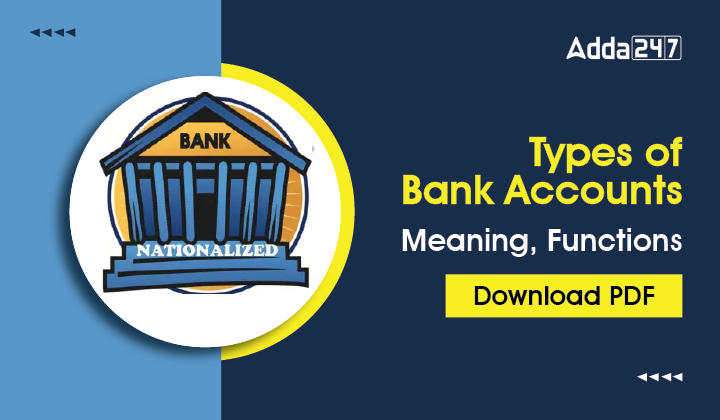Table of Contents
A bank is a financial institution that provides a wide range of financial products and services to individuals, businesses, and governments. These products and services typically include savings accounts, checking accounts, loans, investment services and credit cards etc. It is a financial entity that is allowed to receive funds and provide loans. The interest rate charged by the bank from borrowers and fees charged for any service provided are some of the major revenue sources of banks.
Functions of Bank
The major functions performed by different types of banks are almost the same. However, the set of people or sectors a bank deals with may differ from other types of banks. These functions can be divided into two categories as follows:
Primary Functions
The primary function that every bank perform are accepting the money in form of deposits and granting loans and advances.
- Accepting Deposits: Banks accept deposits from the public and provide them interest on the money deposited by them. Banks assure their customers about the safety of their money and provide them with the facility to withdraw money anytime they want.
- Granting Loans: Deposits in banks is further granted as loans and advances to the public and bank charge interest on these loans and advances. Generally, the interest rate is higher than it is on deposits. Loans and advances can be granted via Bank Over Draft, Cash Credit, loans (provide loans of short, medium and long term), discounting of bills etc.
Secondary Functions
These functions are performed other than the primary functions. secondary functions include functions of two types – Agency Functions and Utility Functions. These are briefly explained as follows:
- Agency Functions: here, a bank acts as an agent for its customer and performs different functions as an agent on its customers’ behalf. Examples of agency functions are:
- i) Transfer of funds from one account to another or from one branch to another,
- ii) Doing periodic collections such as pension/salary/dividend/interest, etc. on behalf of the customer,
- iii) Making periodic payments such as rent, electricity bills, etc. on behalf of the customer, collecting cheques on behalf of its customers,
- iv) Managing the portfolio of the customer by purchasing and selling securities on behalf of the customer, etc. Banks charge fees for providing these services.
- Utility Functions: These are performed by banks including issuing letters of credit, Locker facilities for the safe custody of valuable things such as jewellery, important documents, etc., helping customers in dealing with foreign exchange, underwriting shares and debentures, etc.
Types of Bank Accounts
Banks have to perform several functions like accepting deposits and granting loans. This requires banks to offer different types of bank accounts to people depending upon the purpose, needs, location, etc. of the customers. Some of these are briefly explained as follows:
- Current Account
It is a type of account which fulfils the needs of business houses, traders, entrepreneurs, etc. who make and receive payments multiple times a day. There is no limit on the number of transactions one can do per day. This account provides the facility of overdraft also. No interest is provided to account holders on the amount deposited by them in this account.
- Savings Account
These are regular savings deposit accounts. The account holder can deposit money and earn a minimum rate of return in form of interest on it. In the case of savings accounts, there is a limit imposed by banks on the number of transactions one can do. Banks offer a variety of savings accounts depending upon various factors such as the age of the depositor, his/her purpose of holding the account and many more. Savings accounts can be regular savings accounts, savings accounts for children, senior citizens, family savings accounts, etc. Banks also offer the facility open savings bank accounts at zero balance. Auto sweep, debit cards, and cross-product benefits are other features that banks offer to their customers along with savings accounts.
- Fixed Deposit Account
As the name suggests fixed deposit accounts are types of accounts in which a fixed amount of money is deposited and gets locked in for a certain period of time generally ranging from 7 days to 10 years. Account holders cannot withdraw any amount from the fixed deposit account until it matures. These accounts provide a decent rate of returns to the account holder. The amount of interest depends upon the tenure of the Fixed Deposit. Premature withdrawals are subject to a penalty of a low rate of interest
- Recurring Deposit Account
In such type of account, one has to deposit a fixed amount of money regularly (once a month or quarter depending on the terms of the account) for a fixed tenure. The rate of interest is more as compared to the savings account. If one withdraws money before the maturity period bank will charge a penalty in form of a low rate of return.
- Salary Account
It is an employee’s account in which the employer deposits their salary every month. For opening salary accounts for employees employer needs to tie up with the bank. It cannot be opened by any individual alone.
- NRI Accounts
Banks also offer opening bank accounts to Non-Resident Indians or people of Indian origin living overseas. The types of accounts offered are
- Non-resident Ordinary (NRO) savings or fixed deposit account in which the NRI deposit money usually of foreign currency gets converted into INR at the prevailing exchange rate. One can deposit Income on these accounts are taxable.
- Non-Resident External (NRE) savings or fixed deposit account in which only money earned from abroad can be deposited and gets converted to INR at the prevailing exchange rate. Interest earned on this account is not taxable in India.
- Foreign Currency Non-Resident (FCNR) Accounts are maintained in foreign currency. Deposits are not converted to INR. Both principal and interest can be transferred and are not taxable in India.
- DEMAT Account
DEMAT Account stands for dematerialization account in which shares or securities owned by the account holder are held in electronic form. Demat account helps the account holder to easily buy and sell securities.
Thus, we can say that banks come up with a wide range of options for managing finances that are safe and secure and provide a decent rate of return on money deposited. It is the most preferred mode of saving money. Almost every person in the world has a bank account in the present era.
Types of Bank Accounts Notes PDF
The candidates can easily download the Types of Bank Accounts Notes PDF to easily refer to the notes. Types of Bank Accounts NOtes PDF will come in handy at the time of preparation and revision for the UGC NET Commerce Exam 2023.
Types of Bank Accounts Meaning, Functions Download PDF
| UGC NET Related Articles | |
| UGC NET Notification 2025 | UGC NET Application Form 2025 |
| UGC NET Previous Year Question Paper | UGC NET Syllabus |




 KTET Previous Year Question Papers PDF D...
KTET Previous Year Question Papers PDF D...
 KTET Preparation Tips 2025, Online Prepa...
KTET Preparation Tips 2025, Online Prepa...
 DSSSB Teacher Salary in Hand For TGT PGT...
DSSSB Teacher Salary in Hand For TGT PGT...




